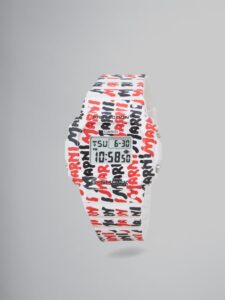The Rennie, a Kamilaroi artist, has spent over two decades forging a distinctive path in contemporary art. By blending street art aesthetics with traditional Aboriginal motifs, Rennie challenges the conventional distinctions between “traditional” Aboriginal art and modern artistic expressions. His work is a dynamic celebration of identity, culture, and resistance, offering a bold voice in contemporary Indigenous art.
Rennie’s art has gained international acclaim for its ability to bridge cultural heritage with urban and global aesthetics. Through murals, sculptures, neon installations, and multimedia pieces, he brings Aboriginal identity into the present, dismantling stereotypes and redefining what contemporary Aboriginal art can be.
Cultural Identity Through a Modern Lens
Born in Melbourne, Rennie grew up disconnected from his Kamilaroi heritage due to the impressions of colonial assimilation policies. However, as an adult, he reconnected with his cultural roots and began integrating them into his art. Traditional Kamilaroi designs, such as diamond patterns symbolizing cultural continuity and connection to the land, became central motifs in his work.
But Rennie’s approach is far from conventional. His use of bold colors, graffiti techniques, and urban iconography positions Aboriginal culture as a living, evolving narrative rather than a static tradition. This juxtaposition of the ancient and the contemporary underscores his central theme: Aboriginal identity is both rooted in history and relevant in modernity.
Key Works: Bridging Tradition and Urbanity
“REMEMBER ME” (2020)
One of Rennie’s most iconic works, REMEMBER ME, is a monumental neon sculpture spanning 15 meters. Displayed prominently at the 22nd Biennale of Sydney, the piece serves as a modern memorial to the Frontier Wars and the resilience of Aboriginal communities. Its glowing pink letters demand recognition and remembrance, highlighting the struggles and survival of First Nations peoples in a colonized Australia.
“Initiation OA_RR” (2021)
This three-channel film is a striking example of Rennie’s ability to blend cultural references with contemporary mediums. It features Rennie driving a custom-painted, bright pink 1973 Holden Monaro through urban and remote landscapes. The car, adorned with Kamilaroi designs, represents cultural and personal identity, while the film draws parallels between modern car culture and traditional initiation rites.
Large-Scale Murals and Street Art
Rennie’s large-scale murals are a key part of his practice, often found on the walls of cities worldwide. These works incorporate Kamilaroi designs and street art techniques, making Aboriginal culture highly visible in urban spaces. His murals have become cultural landmarks, sparking conversations about identity, land rights, and the ongoing presence of Aboriginal peoples.
Challenging Stereotypes Through Art
At the heart of Rennie’s practice is his refusal to conform to expectations about what Aboriginal art should look like. For centuries, Indigenous art has been boxed into categories defined by Western perspectives, often labeled as “traditional” or “authentic” only if it adhered to certain visual tropes.
Rennie disrupts this narrative by refusing to be confined. His work unapologetically blends graffiti—an art form rooted in rebellion—with the sacred patterns of his Kamilaroi heritage. This fusion challenges the binary between traditional and contemporary, asserting that Aboriginal culture is dynamic, adaptable, and constantly evolving.
The Exhibition: REKOSPECTIVE
In 2024, the Ian Potter Centre: NGV Australia presented REKOSPECTIVE, the largest exhibition of Rennie’s work to date. Spanning over two decades, the exhibition featured more than 100 pieces, showcasing his evolution as an artist and his consistent exploration of identity, culture, and politics.
The exhibition was immersive, with themes woven throughout rather than displayed chronologically. Visitors were greeted by Rennie’s bold neon works, intricate sculptures, and vibrant murals, all of which celebrated his Kamilaroi heritage while addressing broader issues of colonialism, identity, and resistance.
Highlights of the Exhibition:
•Multimedia Installations: Works like REMEMBER ME and Initiation OA_RR offered powerful commentary on remembrance, resilience, and cultural identity.
•Interactive Spaces: Rennie’s immersive installations invited viewers to engage with his art physically and emotionally, fostering a deeper connection to his themes.
•Cultural Continuity: Traditional Kamilaroi designs appeared in every medium, asserting their timeless relevance while recontextualized through contemporary art.
A Global Voice in Indigenous Art
Rennie’s art extends far beyond Australia. His works have been exhibited internationally, from galleries in Europe to public spaces in North America, making him one of the most prominent contemporary Indigenous artists on the global stage. His bold use of color, pattern, and scale resonates universally, while his focus on Aboriginal identity roots his art in deeply personal and political themes.
Through collaborations and installations, Rennie has also introduced Aboriginal culture to audiences unfamiliar with its nuances. By framing his heritage through a modern lens, he challenges global audiences to reconsider their perceptions of Indigenous art and its place in contemporary culture.
Impression and Legacy
Rennie’s work has had a profound impact on both the art world and broader conversations about identity and culture. By merging street art with Aboriginal heritage, he creates a visual language that is both accessible and deeply meaningful. His art acts as a bridge, connecting traditional practices with contemporary audiences and challenging entrenched stereotypes about Indigenous peoples.
His influence extends to other First Nations artists, inspiring a new generation to explore their heritage through diverse and unconventional mediums. Rennie’s success demonstrates that Aboriginal culture is not just relevant but vital in today’s art and cultural conversations.
Redefining Aboriginal Art
Reko Rennie’s career is a testament to the power of art as a tool for resistance, identity, and connection. By blending street art with Kamilaroi traditions, he has created a body of work that defies categorization, asserting that Aboriginal culture is as contemporary as it is ancient.
Through exhibitions like REKOSPECTIVE and landmark works like REMEMBER ME, Rennie continues to challenge perceptions and inspire change. His art invites us to reconsider our understanding of identity, culture, and the role of tradition in the modern world. As his career progresses, Reko Rennie remains a bold and visionary voice, ensuring that Aboriginal culture is seen, heard, and celebrated on a global stage.
No comments yet.








